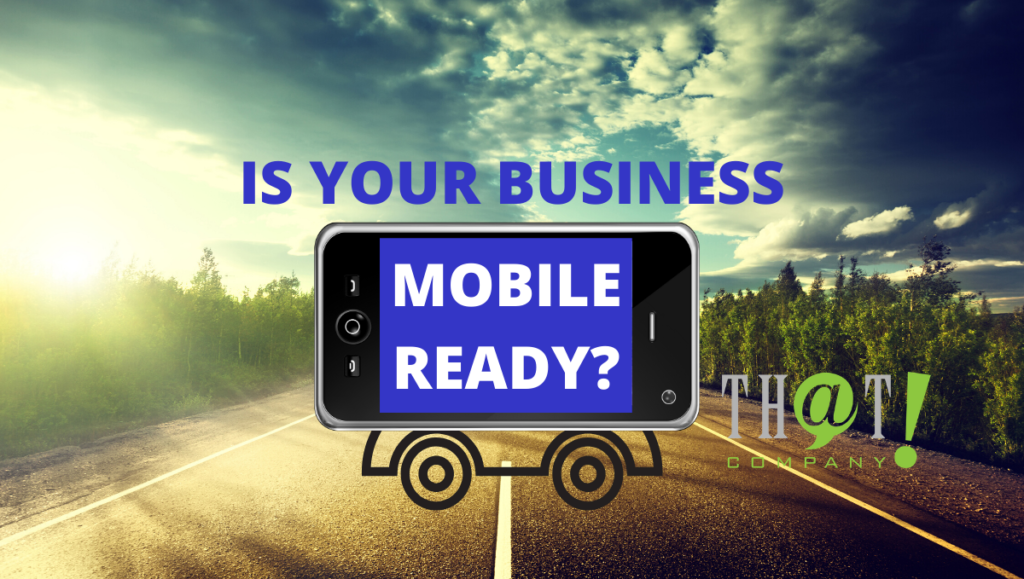 Nowadays, when the question “Are you a Mobile Ready Business?” is asked, many will assume it means, “Is your website responsive?” Is your business designed to be viewed by mobile users? However, with the current situation of the nation dealing with the coronavirus pandemic, this question takes on a whole new meaning.
Nowadays, when the question “Are you a Mobile Ready Business?” is asked, many will assume it means, “Is your website responsive?” Is your business designed to be viewed by mobile users? However, with the current situation of the nation dealing with the coronavirus pandemic, this question takes on a whole new meaning.
In mid-March of 2020, many US states were pushing “Shelter-In-Place” orders that made it mandatory for certain “non-essential” businesses to close their doors. For some, mainly small businesses, this translated into closing their doors for good, as any substantial amount of time without revenue would make it impossible for them to recover after the pandemic was over. Some businesses were able to remain operational, though most with a decreased workload, but even those were being pressured to close their doors and send workers home to perform their “social distancing” duties. However, many companies were able to escape, almost totally unscathed and in a business sense, unaffected by the pandemic because of the ability mentioned above: They were a true mobile-ready business.
Introducing Remote Working Capabilities
 Most employees who work daily in an office dream of being able to work from home instead. The idea of avoiding the entire commute to work, the lack of comfort in the work area, and in some cases, the social interactions with less-than-savory co-workers is appealing. Most employers ignore this desire as the risks of allowing work from home can be to productivity and also security. The employer has more than enough reasons not to pursue remote working capabilities. Yet, they frequently overlook the many benefits of remote working, and sometimes they realize them too late.
Most employees who work daily in an office dream of being able to work from home instead. The idea of avoiding the entire commute to work, the lack of comfort in the work area, and in some cases, the social interactions with less-than-savory co-workers is appealing. Most employers ignore this desire as the risks of allowing work from home can be to productivity and also security. The employer has more than enough reasons not to pursue remote working capabilities. Yet, they frequently overlook the many benefits of remote working, and sometimes they realize them too late.
Businesses were being shut down across America during the pandemic. Many companies were either forced to close or did so voluntarily, as the mandatory order was inevitable. Others turned to their remote working capabilities. Conference lines were set up, servers were started, CRMs were heavily monitored, and clients were notified of the small changes that may occur when switching on “Remote Mode.” A lot of mobile-ready businesses implemented their remote working capabilities and were mostly unaffected by the mass shutdowns. Some of them were even able to find a benefit in continuing business in areas where competitors had suddenly gone silent. New eyes were browsing their products because now other products were available to browse. Because they were mobile-ready, businesses like these had found their silver lining.
How to Build a Mobile-Ready Business
Now obviously, some businesses will never be able to go completely remote. Others will only be able to partially use remote working capabilities, while many may be able to go completely remote. It all depends on the type of business involved. Companies dealing in digital marketing, or just digital data in general, usually have very little problem with going remote. No matter what kind of business yours is, if you are even thinking of allowing work from home, there are some areas of remote working that should always be included.
Communication
This is by far the most crucial aspect of remote working. Clear communication between staff and clients is a must. Even if everything else in the business somehow stopped functioning, you’ll have a chance to recover if you have clear lines of communication with every part of your business. It is vital to be able to notify potential and current clients successfully. This can come in the form of a simple e-mail system, phone conferencing, messaging systems, or all of the above. The most important aspect of communication is that everyone involved is on the same page with how it works.
Mobile Ready Business Reporting
 To track the progression of a mobile-ready business and all aspects of it, a reporting system needs to be implemented that can be accessed from wherever the current workplace is. While communication is the most important, having a conversation without data will not progress the communication forward. Before staff can begin working from home, they need to make sure everything they would typically need daily at the office is also accessible to them from a remote working area. This system needs to be continuously tested and modified until working seamlessly from home and in the office functions.
To track the progression of a mobile-ready business and all aspects of it, a reporting system needs to be implemented that can be accessed from wherever the current workplace is. While communication is the most important, having a conversation without data will not progress the communication forward. Before staff can begin working from home, they need to make sure everything they would typically need daily at the office is also accessible to them from a remote working area. This system needs to be continuously tested and modified until working seamlessly from home and in the office functions.
Time Management System
This could also be titled “Accountability,” since that is one of the main points a time management system will help to cover. However, the system will also help with much more. The task management system should not be personal. It should be a shared program that dialogues and dictates current and future tasks being handled by all employees of the company. This not only gives an account of how employees are using their hours when working remotely but also keeps track of what each department and individual is involved in and gives a larger picture to CEOs if the remote working capabilities are staying as productive as can be.
New employees should be able to jump into a task management system and find out what has been done and what needs to be done without much confusion. Next to “Communication,” a functional task management system is of the highest priority when establishing remote working capabilities.
[bctt tweet=”New employees should be able to jump into a task management system and find out what has been done and what needs to be done without much confusion.” username=”ThatCompanycom”]A Loyal Workforce
Pro Tip for Remote Working:
Best Practices When Working Remotely During COVID-19 | Staying On-Task
Suddenly a lot of us are starting to work remotely, in this article I’ll cover the challenges and solutions to this new environment. Figuring out a way to stay healthy is just as essential for yourself as finding a way to keep your business alive during this pandemic.
Let’s face it; some of our workers really don’t like to work. A few of them may see remote working capabilities as a way to get the “eye off their shoulder” and a chance to get paid for lack of productivity. Although digital time clocks, task management systems, and clear communication may all be in place to assist accountability, workers sometimes find loopholes and workarounds and don’t produce as well at home as they would in the workplace.
There is really no advice here that can help with that. Merely a statement. A mobile-ready business will succeed best when loyalty is already built into the workplace. Employees must want to do their jobs for them to work just as hard at home as they do in the office. They must be willing to help save their business for them to sit a few feet away from their beds and not nap instead of working. Before you even consider obtaining remote working capabilities, ensure the loyalty of your employees can handle it.
A Mobile Ready Business is Better Prepared
When times get tough for businesses, as they have during the coronavirus pandemic, it’s best to switch to plan B than to let Nature or the government choose a new plan for you. You may never have to implement your remote working capabilities. You may have employees who love their jobs so much that although the ability to work from home exists, they’d rather be in the office (it’s rare, but believe me, it exists). But what you do not want is to stand there, closing your doors for good, wishing you had thought of going mobile.
In a time when you watch your competitor close up shop and stop advertising, sending all employees home, you’d do yourself and your whole company’s family the most good by preparing your business with the ability to go mobile. You never know, even attempting to create a mobile-ready business may produce some of the employee loyalty that would allow it to succeed. Preparation will make the difference between “Restarting” and “Recovery.”





























